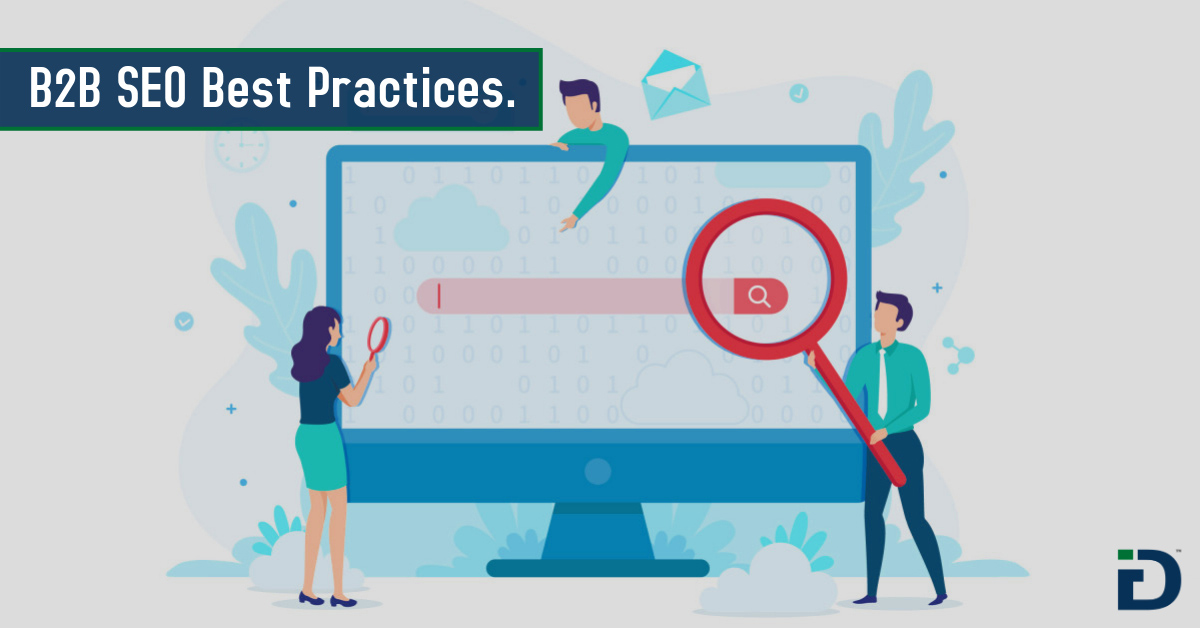

Contact
+91 8591174212Let's work together to bring your products and services to new digital heights!
Get in Touch

Sep 03, 2020

In the current SEO scenario, it is strenuous to project its worthiness for the year to come. Your SEO strategy is not going to remain constant, due to a variety of factors like algorithm updates, change in user behavior, new technology advancements, the introduction of various platforms or features to an application, changing industry lobby rules and regulations, and many more. As we ponder on the years to come, we think it would be good to establish a few critical SEO best practices for B2B businesses that will have a positive impact on your designed SEO strategy.
Below are 12 must consider best practices and tips to help improve your search engine optimization strategy in 2020.
1/12: Build personalized content:
Time and again we have been emphasizing how vital content is for your digital marketing strategy. Hence, it tops the list at number 1. It is important to think about what the buyer wants to read. This means your content team needs to brainstorm on designing content that talks directly to the buyer’s pain areas. The team would require to run some research surveys to understand your target group and their needs which you can solutionize. This procedure is time-consuming but absolutely worth it. Once you narrow down your research with few pain points of your target audience you can design blog articles, webinars, videos, infographics that will directly attack the problem statement. Firstly, try and build content around a question-based approach. Here you can develop content that answers question-based queries. This is because most of the audience on google start a search with a question. Secondly, you must focus on creating extensive content. Longer pieces of information allow the audience to be on your blog page for longer. Also, your SEO content strategy must incorporate extensive assets like whitepapers, eBooks, guide books, or other premium content assets. Thirdly, make your content easy to find. Make sure visitors don’t have to be hassled to find information on your website, which means have a standard, well acceptable website navigation design. With the successful implementation of this point, you can expect a rise in organic traffic. Lastly, Take advantage of blogs and various content publishing forums. Answering questions that people ask on various blogging platforms is a very effective way to generate website traffic. Start with creating accounts on various relevant blog forums where you know your audience is hungry for information.
2/12: Create impactful landing pages:
As per bookish knowledge, the more landing pages you create, the more you are likely to spike up your organic website traffic. But we recommend putting quality over quantity. Constructing a well thought through landing page is critical to generate leads and improve conversion rates.
How can you judge if your landing page is impactful? Start by checking out the competitor’s landing pages. Ask yourself. What is your competitor offering, which you ain’t? The answer shall help you to fill in the minor gaps on your landing page. You can also study how many people actually link to your landing pages or hare them on social media websites. If you have other sub-pages that are capturing likes and shares, then consider redesigning your landing page on similar grounds. Another critical aspect of your landing page is website speed. You have only a few seconds to make an impression and website speed can be a major turn-off. A slow page loading speed hurts your Google ranking.
3/12: Spend ample time on keyword search:
Over the years Google has evolved and has become much more intelligent when it comes to user’s intent behind a search query. The point here is to think beyond general keywords. Here you can search for specific/focused keywords that are targetted to a specific audience only. YOu will need to spend more time studying your audience. You can also consider looking at current trending searches in order to be visible in trending search topics. Keyword density is another critical topic under keyword placements. This implies narrowing down, how many keywords are good to appear on 1 website page. Keywords by length have to be kept in mind while finalizing your keywords. A long-tailed keyword is known to be target focused, low at competition, less searched for but higher conversions as its very specific in nature.
E.g: Short-tail keyword: Digital marketing agency whereas a long-tail keyword would be: SEO services in Mumbai.
As noticed the long-tail keyword focuses on one digital marketing service called SEO and also defined the geographical region. This will be definitely not searched for often, but when searched for would foster higher conversion probabilities.
4/12: Stay up to date with google’s volatile algorithms:
You as an SEO expert can optimize content and SEO strategy often but one must not miss out on the fact that Google can change/remove/add algorithms whenever they want. For Google, visitor’s user experience is of utmost importance. Hence, they are continuously striving for the same by updating search algorithms that no one can completely track. You need to keep yourself up to date which such changes and then optimize your SEO strategy accordingly. Google liked to display a search according to the searcher’s query. Hence, schema markup is becoming more important than before. This includes rich snippets, answer boxes AMP results, reviews, testimonials, etc. Shema markup makes it easier for engines like Google, Bing, Yahoo, etc to understands your website and ensures that your B2B brand is displayed correctly to the visitor.
5/12: Make your website is mobile responsive:
With the ever-increasing access to mobile internet, making your website mobile-friendly and scalable to all devices is not only important by absolutely unavoidable. This means while you are developing your website on a desktop/laptop you must ensure its scalability on tablets and mobile phones. This is where you will have to consider legible font styles, size and colours. This decision will impact website load time and navigation while ultimately impacts conversions.
6/12: Secure your site (https):
Did you know, Google has been considering to call off unsecured websites from its search results page? Which boils us down to a critical question, Is your website one of them? How do we answer this question? Does your website have an HTTPS prefix? If not, you’re in for great trouble.
Search engines have been striving to provide secured search pages to their users. They also have considered boosting your page ranking if you have a secured website. Now you know how critical is an HTTPS prefix? Do not wait for Google’s consideration to become reality, as it will hit your business hard. Get your website secured today.
7/12: Leverage chatbots for SEO:
With chatbot integration on your website, you can handle routine queries seamlessly. This also allows you to be timely in responding also improving your TAT (turn around time) for a given query. This will not only improve user experience but also boosts engagement. When you talk about visitor engagement on your website, a chatbot takes it to another supreme level. This also favors knowing your audience better due to the personal connection a chatbot delivers.
8/12: Acquire links across domains:
One of the most critical parameters responsible for your SEO ranking is how many relevant domains are linked to your website. In fact, research says the more domains linked, the higher the website will rank. We recommend you leverage various online forums, online community discussions, social media websites to increase domain linkage. To climb the SEO ranking ladder quickly hunt for high-quality domains or publications and get them to link back to your website.
9/12: Do not sideline SMM:
Though Social media marketing is not directly responsible for your website’s SEO ranking, it is a salient factor. Poor social media visibility would mean your brand is not willing to connect with its target group. This shuts many doors which would foster brand building and awareness generation. If not social media campaigns you can at least leverage social media websites to share launches, new features, or any important data which will make your brand more visible than before. This will not only impact organic search visibility but also is an effective tool for lead generation. If your brand is not on any of the social media website’s you are missing out on the initial action.
10/12: Do not underestimate the power of videos and infographics:
Infographics are responsible to grab the attention of your audience and Video advertising adds a personal touch to your advertising campaign. High-quality visual information naturally supports link building efforts and organic website traffic.
11/12: Leverage AMP benefits:
Simply put, Accelerated Mobile Pages(AMP) is an open-source initiative project designed to optimize faster mobile pages. It is aimed at helping publishers improve the speed and readability of their mobile content pages. How does this help your SEO ranking? If your website has an AMP implemented on it, your content will be shown more frequently yo users trying to search you through their mobile phones. Google is also prioritizing mobile-first indexing as a means to boost browsing user experience.
12/12: Optimize local business listings:
Most businesses miss the fact that tapping the local market can comprise 50% of your business revenue. Local business pages are the most simplest and efficient way to improve your SEO ranking. Google is also planning to move slowly to local search, so you must ensure your local listing is optimized. Here you must keep in mind that both the user and the search engines are able to find your latest information.
Final thought:
By successfully implementing these best practices, B2B organizations can leverage quality lead generation, foster valuable relationships to support link building, boost brand visibility online through various online communication websites, and finally increasing conversion/sales.
Ref:
https://komarketing.com/blog/b2b-seo-best-practices-2017/
Let’s build a smarter, more connected future for your business. Get in touch with us today!

Office Address
6th Floor, Office Number 603, Ashok Premises, Old Nagardas Crossroad, Opposite Saraswati Towers, Andheri East, Mumbai, Maharashtra 400069
info@idigitize.co
Contact
@ 2024, iDigitize I All Rights Reserved I Designed, Developed & Managed By iDigitize Infotech LLP